Apistogramma panduro (aka sp. "Pandurini")
Here's an illustrated
spawning article by Dave Sanford, from the Greater Seattle Aquarium Society.
Contents:
- multiple pandurinis?
by lisa wrischnik <wrisch/mendel.Berkeley.EDU> (Fri, 17 Jan 1997)
- A."pandurini"
by SanfordD/liberty.issaquah.wednet.edu (Sanford, Dave LHS-STAFF) (Wed, 22 Jan 1997)
- naming
by Elson/Frauley <fraulels/minet.ca> (Wed, 19 Mar 1997)
- A. panderini
by Pete Johnson <petej/tlg.net> (Tue, 27 Aug 96)
- RE: Apisto. Nijsseni?
by Thomas Mroz <tmroz/art-inc.com> (Tue, 12 Nov 1996)
- A."pandurini"
by SanfordD/liberty.issaquah.wednet.edu (Sanford, Dave LHS-STAFF) (Fri, 20 Dec 1996)
- panduro vs. "pandurini"
by Jota Melgar <76644.2370/compuserve.com> (Tue, 2 Dec 1997)
- panduro vs. "pandurini"
by Jota Melgar <76644.2370/compuserve.com> (Wed, 3 Dec 1997)
- panduro vs.
by "Ed Pon" <edpon/hotmail.com> (Thu, 04 Dec 1997)
- A. panduro
by Bill MacIndewar <wmac/reading.mec.edu> (Thu, 4 Dec 1997)
- Fwd: RE: panduro vs.
by "Ed Pon" <edpon/hotmail.com> (Thu, 04 Dec 1997)
- panduro vs.
by "Mroz, Tom" <tmroz/art-inc.com> (Thu, 4 Dec 1997)
- Pandy vs nijsseni
by Ken Laidlaw <K.Laidlaw/roe.ac.uk> (Sat, 6 Dec 1997)
- Feeding wild fish and A.panduro (long)
by Ken Laidlaw <K.Laidlaw/roe.ac.uk> (Wed, 4 Feb 1998)
- Panduro
by Mike & Diane Wise <apistowise/bewellnet.com> (Thu, 27 Aug 1998)
- A.nijsseni
by Frauley/Elson <fraulels/minet.ca> (Tue, 29 Sep 1998)
- njisseni/panduro thread
by Frauley/Elson <fraulels/minet.ca> (Sun, 01 Nov 1998)
- Panduro x Nijsenni???
by Mike & Diane Wise <apistowise/bewellnet.com> (Fri, 05 Nov 1999)
- Differences between A. Nijsseni & A. Pandurini?
by Mike & Diane Wise <apistowise/bewellnet.com> (Tue, 13 Feb 2001)
|
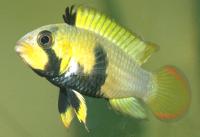
female
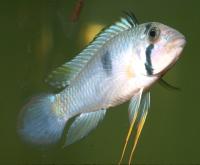
male
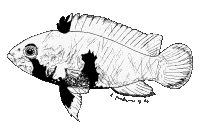
female
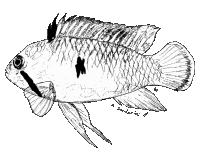
male
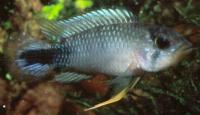
male
|
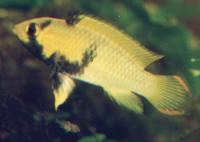
female with fry
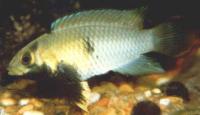
female
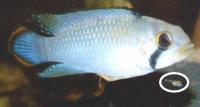
male, guarding fry
|
by lisa wrischnik <wrisch/mendel.Berkeley.EDU>
Date: Fri, 17 Jan 1997
To: apisto/aquaria.net
Hi all,
I've had a bad streak lately-over X-mas I lost my tiny spawn of
A. 'pandurin' fry and my female T. candidi just ate her spawn,
too. Damn!
Gary just mentioned that he thinks there might be two versions of
the 'pandurini': #1 being (paraphrased) a souped-up nijsseni
w/ a sky blue body and red-orange tail edging and #2 having a
large black spot at the base of the caudal fin w/ an aggie-like
tail. I think the first one is just what you said, a "souped-
up nijsseni", and not a 'pandurini' at all. I think this has
been mentioned previously (apologies to whomever I'm forgetting
to credit here), but my 'pandurini' came in as nijsseni with
nijsseni, so I think Gary may have just picked up a really good
looking male nijsseni. I have had beautiful males that were
bright blue with striking red on the tails, and a few other
"dull boys" as well.
The second version definitely sounds like a pandurini to me. Has
anyone else noticed that when they calm down, they lose that
tell-tale caudal marking? My male is basically cream colored with
a light blue sheen and a light blue caudal fin edged in red.
No lateral markings at all.
Gary, if you think I'm full of it, please let me know! I would
be happy to find out if there really is another member of this
complex because they are my favorite apistos, and it just
means there is something else exciting to look for.
Lisa
by SanfordD/liberty.issaquah.wednet.edu (Sanford, Dave LHS-STAFF)
Date: Wed, 22 Jan 1997
To: apisto/aquaria.net
Hi everyone, I've had pandurini since Aug. They were about 2/3
grown when i got them. The female has the black throat and ventrals
but nothing on the caudal peduncle. The male had a prominent black
"diamond" blotch on the c.peduncle extending into the tail, with
the red margin, but the red had a gap in the center of the tail.
He has just about lost the black blotch now. Sky blue is a good
description of his body color.
They spawned within a week of adding Waters of the World, SA formula
which lowered the pH to about 5.5. My water is very soft, no carbonates,
or buffers, about 7.5 out of the tap. 1st spawn was about 10 fry,
which they ate and spawned again, same number, which lasted about
2 weeks then they ate them and spawned again. One month ago they
spawned and had about 30 fry, of which 10 are 3/8 in in size now.
Last week i noticed about 50 red eggs just lying on the glass
bottom. Thinking that they would just fungus, or be eaten i waited
for them to disappear. This week i saw a cloud of 30 fry being
hearded by the female, with the older fry intermixed! This is common
with lake Tanganyika cichlids but i've never observed it with Apistos.
I think size of spawn is mostly related to maturity, and less related
to diet as long as they are adequetly fed. Mine will not even look
at flake so they get baby brine shrimp, adult bs, and when weather
permits live daphnia and mosquito larvae.
Pandurini has become one of my favorite dwarfs, and i'm glad
that several of you are raising them.
Dave
by Elson/Frauley <fraulels/minet.ca>
Date: Wed, 19 Mar 1997
To: "apisto/aquaria.net" <apisto/aquaria.net>
Hi all,
A couple of months ago I drove you all crazy with my 'neo-pandurini' debate,
when I wanted to see if anyone else had lucked into what appears to be a bridge
species/form between pandurini and njisseni. Now, they've spawned and I have a dozen or
so healthy, but young, fry. Assuming (big assumption) they survive, what should I call
them? sp. affinis undescribed? a killie-style number tag? If the young eventually breed
true, then they probably aren't a cross, and from the importation history, I think they
are what they appear to be - a bridge. If I can spread some around (another big
assumption), there should be a way of keeping them distinct from their relatives, and
names go a long way.
What would you do?
Gary (Montreal)
----------- Reminder: Kindly quote parsimoniously when replying -------------
This is the apistogramma mailing list, apisto-at-aquaria.net. To subscribe or
unsubscribe or get help , send the word "subscribe" or "unsubscribe" or
"help" in the body (not subject) to apisto-request-at-aquaria.net
by Pete Johnson <petej/tlg.net>
Date: Tue, 27 Aug 96
To: "apisto" <apisto/aquaria.net>
Ray Cone writes:
>I'm still on my maiden voyage into "Apisto-land" and would appreciate
>some advice. I have recently purchased three pair of A. Pandorini and
>can't seem to find descriptions of their habitat/water chemistry
>requirements in the literature. Could you or someone on the list offer
>some wisdom on this along with suggestions for breeding set-ups? Also,
>what is considered, "the book," for Apisto reference? Thanks in advance
>for any and all friendly reply's.
A. panderini, also known as the Blue Sky Apisto, is a brand new import,
which is why you can't find information on it. It reportedly comes from a
similar habitat to A. nijsenni, which it somewhat resembles, so pretend
that it's A. nijsenni, which likes very soft, very acid (5.0 pH) water.
The best current standard English-language reference is Linke & Staeck's
American Cichlids 1 (Tetra Press). A new arrival with many more new
species is the Aqualog series, printed in Germany.
Where did you find your A. panderini? They're showing up now in Northern
California, shipped in as "A. nijsseni."
----------------------------------------------------
If wishes were fishes we'd all have ponds.
Pete Johnson San Jose, CA petej-at-tlg.net
----------------------------------------------------
by Thomas Mroz <tmroz/art-inc.com>
Date: Tue, 12 Nov 1996
To: "mengerin/cs.utexas.edu" <mengerin/cs.utexas.edu>,
Thanks for the replies. I looked at these fish some more last night
after posting and found a few other details that might help describe
them:
The "male" has a light blue spade-like patch that starts at the Caudal
Peduncle and extends into the Caudal fin. The female has this as well,
but hers is black. The male has fairly bright yellow-ish coloration in
the unpaired fins, and has a yellow coloration in the pectoral fins,
which end in red. The female's pectorals are black, with red tips.
Looking at them again, they are definitely a pair.
Here I was trying to figure out how to get A. pandurini when you all
were talking about them a few months ago, and meanwhile, perhaps they
have come to me!
Anybody have breeding success with them? How about pictures on the net?
I am surprised at how well they are doing in my tap water, which is
typically about 160 ppm, and a pH in the mid-7's. They are really quite
vigorous - much better than Nijsseni which I have kept before, even
those that I kept in "appropriate" water conditions.
Tom
>----------
>From: mengerin-at-cs.utexas.edu[SMTP:mengerin-at-cs.utexas.edu]
>Sent: Tuesday, November 12, 1996 1:53 PM
>To: Thomas Mroz
>Subject: Re: Apisto. Nijsseni?
>
>> the nice, black ventral fins. The other half had the clear, yellow fins
>> you would expect from a male. Further, the "males" central spots were
>> smaller, and round, whereas the "females" spots were more like blotches,
>
>That sounds like the potential subspecies, Apistogramma pandurini
>("Blue Sky").
>There is some debate as to whether or not it is a njisseni or a not,
>but other
>than some patch work and a little difference in coloring they look
>exactly
>alike.
>
> Cheers,
> Matthew
>
by SanfordD/liberty.issaquah.wednet.edu (Sanford, Dave LHS-STAFF)
Date: Fri, 20 Dec 1996
To: apisto/aquaria.net
Hi, I'm amazed that Gary got his Pandurini to spawn at pH 6.5.
Mine did nothing until lowered to about 5.5, just like my A.nijsseni.
I agree with Mike that at least 3 weeks before raising the pH in
the fry tank, and that it should be done very slowly.
I wrote an article on them that will be published in the Northwest
Aquaria, the newsletter of the Greater Seattle Aquarium Society, don't
know which month yet.
by Jota Melgar <76644.2370/compuserve.com>
Date: Tue, 2 Dec 1997
To: "INTERNET:apisto/majordomo.pobox.com" <apisto/majordomo.pobox.com>
Bill wrote:
>Are A.sp. "pandurini" and the newly described A. panduro considered
to be the same fish?<
A. "pandurini", A. "coriati", and A. panduro are all the same species.
Julio
-------------------------------------------------------------------------
This is the apistogramma mailing list, apisto-at-majordomo.pobox.com.
For instructions on how to subscribe or unsubscribe or get help,
email apisto-request-at-majordomo.pobox.com.
Search http://altavista.digital.com for "Apistogramma Mailing List Archives"!
by Jota Melgar <76644.2370/compuserve.com>
Date: Wed, 3 Dec 1997
To: "INTERNET:apisto/majordomo.pobox.com" <apisto/majordomo.pobox.com>
Ken,
Uwe Romer recently described A. panduro in the last issue of the BB. This
has pissed off some ichtyologist but that's a different story. Males A.
panduro are easily distiguished from A. nijjseni by the prescence of a
black triangle that goes from the back insertion of the anal fin, through
the caudal peduncle, and almost to the red margin of the caudal fin
Uwe reports on some unsuccesful crosses between A. nijjseni and A. panduro
of wild caught fish. Females would not accept heterospecific males. F1s did
breed but the offspring proved to be sterile. This however is not definite
prove but a strong suggestion that they are different species. Anyone
interested in doing some molecular systematics on these guys?
Julio
-------------------------------------------------------------------------
This is the apistogramma mailing list, apisto-at-majordomo.pobox.com.
For instructions on how to subscribe or unsubscribe or get help,
email apisto-request-at-majordomo.pobox.com.
Search http://altavista.digital.com for "Apistogramma Mailing List Archives"!
by "Ed Pon" <edpon/hotmail.com>
Date: Thu, 04 Dec 1997
To: apisto/majordomo.pobox.com
>
>Uwe Romer recently described A. panduro in the last issue of the BB.
This
>has pissed off some ichtyologist but that's a different story. Males A.
>panduro are easily distiguished from A. nijjseni by the prescence of a
>black triangle that goes from the back insertion of the anal fin,
through
>the caudal peduncle, and almost to the red margin of the caudal fin
>
I have read in the postings several times the part about the "triangle"
not showing in the "pandurini/panduro". I have observed in store tanks
and my own tanks that the appearance of the "triangle" may be related to
the ph. I have seen a whole tankfull of pandurinis where the fish all
appeared to be males until they were moved to a tank with lower ph. In
other situations, I have seen where a tankful of pandurinis where many
of them did not display the "triangle" and it appeared to be because the
ph was somewhere between 6.5 and 7.0. One of the stores that I
regularly frequent will not adjust the ph of their water lower than
6.5--this appears to keep most of his low ph fish alive.
______________________________________________________
Get Your Private, Free Email at http://www.hotmail.com
-------------------------------------------------------------------------
This is the apistogramma mailing list, apisto-at-majordomo.pobox.com.
For instructions on how to subscribe or unsubscribe or get help,
email apisto-request-at-majordomo.pobox.com.
Search http://altavista.digital.com for "Apistogramma Mailing List Archives"!
by Bill MacIndewar <wmac/reading.mec.edu>
Date: Thu, 4 Dec 1997
To: "'apisto/majordomo.pobox.com'" <apisto/majordomo.pobox.com>
Hello,
Thanks to Julio, Mike, and Ken for their reposnses to my question
regarding A. panduro and A. sp. "pandurini". It is now clear that the two
are actually the same species.
I believe my confusion stemmed from two areas. First, the fish
I most recently obtained came in from Peru labelled as A. sp. "panduroid".
Second, Romer's article in the BB contained no mention of the word
"pandurini", or the connection between panduro and "pandurini". I read
the article again last night just to be sure I had not missed it the first time.
Thanks again,
Bill MacIndewar
-------------------------------------------------------------------------
This is the apistogramma mailing list, apisto-at-majordomo.pobox.com.
For instructions on how to subscribe or unsubscribe or get help,
email apisto-request-at-majordomo.pobox.com.
Search http://altavista.digital.com for "Apistogramma Mailing List Archives"!
by "Ed Pon" <edpon/hotmail.com>
Date: Thu, 04 Dec 1997
To: apisto/majordomo.pobox.com
>Further on Ken's thought - where did Pandurini come from??? It is
>clearly from the "Panduro" root, but makes less sense than "Panduroi"
or
>"Panduro" would have as a temporary name. Perhaps it was just one of
>those bag mispellings on the first shipment?
>
>When the fish was first exported, what was it called. If Panduro
>himself was the first exporter, did he coin the name, or did it come
>later. If he did not coin the name, who did and when?
The first time I saw the pandurini was at a lecture given by Uwe Romer
at the San Francisco Aquarium Society. I don't recall exactly how long
ago it was, but the pandurini was brought in by Uwe Romer and David
Soares as a new fish and called an apistogramma "blue sky". I was told,
and I don't remember by whom, that pandurini or pandorini (I didn't even
know what the spelling was at the time) translates from German (I'm not
German speaking) as "blue sky". I believe that the source of this
information had been either talking to Uwe Romer or David Soares on this
topic (but I could be wrong). Does anybody out there know if "blue sky"
translates to anything in German that even remote resembles pandurini.
______________________________________________________
Get Your Private, Free Email at http://www.hotmail.com
-------------------------------------------------------------------------
This is the apistogramma mailing list, apisto-at-majordomo.pobox.com.
For instructions on how to subscribe or unsubscribe or get help,
email apisto-request-at-majordomo.pobox.com.
Search http://altavista.digital.com for "Apistogramma Mailing List Archives"!
by "Mroz, Tom" <tmroz/art-inc.com>
Date: Thu, 4 Dec 1997
To: apisto/majordomo.pobox.com
Regarding the pandurini description and photos, I found that the
non-breeding males would show the caudal triangle much more clearly than
the adult spawners (essentially constant pH throughout the period,
though I have not checked for pH correlations). Once my male started
breeding, the triangle would only be faint at best. However, the blue
cast to the caudal was nearly always identifiable. Yes, as with many
apistos, these guys change color quite a bit with mood, time of day,
etc. Many of the subadult/young adult males show a distinct body spot
(which unlike the females is smallish, round and in the same general
place). I don't recall seeing this spot on male Nijsseni, or if it is
there, it is much less frequently seen. Does anyone else consider the
spot a species identifier here?
I've been trying to determine how to describe other differences that
exist. I am certain I could separate male pandurinis from male nijsseni
in a mixed tank with good accuracy, but I can't tell you exactly what
attributes would be the indicators. Kind of like telling the difference
between Coke and Pepsi. I'll take that challenge any day with a good
chunk of cash at stake, but I could'nt explain the difference to you in
words. In my experience, the fish are similar looking, though clearly
distinct.
Tom
-------------------------------------------------------------------------
This is the apistogramma mailing list, apisto-at-majordomo.pobox.com.
For instructions on how to subscribe or unsubscribe or get help,
email apisto-request-at-majordomo.pobox.com.
Search http://altavista.digital.com for "Apistogramma Mailing List Archives"!
by Ken Laidlaw <K.Laidlaw/roe.ac.uk>
Date: Sat, 6 Dec 1997
To: apisto/majordomo.pobox.com
Mike,
Thanks for the info, I have a couple of things to add after
looking over some old photographs of A.nijsseni which I
hope may help.
> Caudal Peduncle......nijsseni has no spot and the panduro has a triangle
> when it is settled and comfortable in the tank.
Male A.nijsseni do have a spot (round) on the caudal
penduncle, it seems to be more visible on younger specimens
though
> Female........nijsseni...lateral spot is large and splotch-like and has
> a cheek splotch as well. Panduro has a lateral spot that is not
> terribly large, compared to a nijsseni......panduro female has a cheek
> stripe that is definatly not a splotch.
Female nijsseni have a distinct black spot on the caudal
peduncle. The photograph on Erik Olson's page of the
female panduro does not show a spot. What a beautiful fish
that is.
Another feature of panduro is the extensive area of black
along the underside of the body between the head and the
middle of the body.
> I thought there was a mistake.....no "black
> triangles"........3 days later I was there and they were calmed down and
> the black triangle on the males was OBVIOUS!
My friend has a pair of panduro, I'll check out that
triangular spot.
Ken.
-------------------------------------------------------------------------
This is the apistogramma mailing list, apisto-at-majordomo.pobox.com.
For instructions on how to subscribe or unsubscribe or get help,
email apisto-request-at-majordomo.pobox.com.
Search http://altavista.digital.com for "Apistogramma Mailing List Archives"!
by Ken Laidlaw <K.Laidlaw/roe.ac.uk>
Date: Wed, 4 Feb 1998
To: apisto/majordomo.pobox.com
Hi all,
I have a pair of A.panduro which I just obtained on Sunday.
I do not know whether the fish are wild or not for sure but
I suspect they are as they (especially the male) are not
keen on my usual main food which is frozen bloodworm. All
the Apistos I have kept in the past eat this with relish
but the male panduro ignores it. It will eat live white
worms but I don't want to resort to feeding only live foods.
Now at last my question. Will this fish ever like frozen
food or will it hang out for the live food that I may be
forced to feed all the time?
I only have two tanks at present and they sit side by side.
A pair of A.nijsseni occupy the other tank. I previously
asked on this list if it was easy to distinguish between
these two species and now that I can examine them side by
side it is fairly easy to spot the differences.
The male panduro is a grey/blue colour and doesn't have
much yellow towards the front of the body like the nisseni.
The anal fin in the panduro is a beautiful blue colour as
is the caudal. There are a couple of faint vertical bands
towards the rear of the caudal which are not on the
nijsseni. Both the male and female have a blue top edge to
the dorsal, on nijsseni it is red.
The female has much more black completely covering the
under side of the fish from the head to the middle of the
body. There is no black caudal blotch as in nijsseni
females.
Finally the black triangular caudal marking. In the shop
tank where they were not happy as they were in a tank with
no cover, a jacuzzi like under gravel filter and about 20
clown loaches the triangle was clearly visible. Now at
home though the triangle has gone.
Sorry this is so long!
Cheers,
Ken.
*****************************
Ken Laidlaw
Royal Observatory, Edinburgh
Tel: 0131-668 8100
Fax: 0131-668 1130
Web: http://www.roe.ac.uk
*****************************
-------------------------------------------------------------------------
This is the apistogramma mailing list, apisto-at-majordomo.pobox.com.
For instructions on how to subscribe or unsubscribe or get help,
email apisto-request-at-majordomo.pobox.com.
Search http://altavista.digital.com for "Apistogramma Mailing List Archives"!
by Mike & Diane Wise <apistowise/bewellnet.com>
Date: Thu, 27 Aug 1998
To: apisto/majordomo.pobox.com
cfonda-at-sentientconsult.com wrote:
> Jason wrote:
>
> >Hi all
> >I was just talking to someone who has been importing Apistos for 20 years
> (I
> >don't want to name him!) and he was questioning whether A.panduro was
> really
> >a valid species. The points raised were these:
> >
> >-Why do waters that have been well collected suddenly yield a new species?
> >
>
> Very few individuals know where A. panduro's are collected. (It seems to
> be a closely guarded secret, though I have heard that Romer's new book will
> have the info.) I believe that Julio knows, but he was in S.A. last I
> knew.
Apistogramma panduro is found in small tributaries of the Rio Tahuayo, a right
bank (eastern) tributary of the Rio Ucayali. This is close to the area where A.
nijsseni is located.
> Also, heavily collected waters are no more immune to new discovery
> than any other waters -- new discovery may be less likely, but it is not
> that uncommon.
>
> >-Apistos sp. apparently get offered for sale a couple of months here and
> >there, but not steadily for a year and half as for A. panduro.
Apistogramma pandurini is so commonly available because several German hobbyists
(Uwe Römer being one of them) reproduced them in large numbers from the first
group brought in by Aquarium Glaser in June 1996.
> A. panduro is not A. sp. panduro any longer... Romer published the original
> description of the fish in JACA. He ticked the classification experts off
> because JACA is a "hobby" journal. Kullander himself later "re-did" the
> description and had it "properly" published. (I use the quotes because
> these are the claims of others, with which I neither agree nor disagree.)
Kullander has NOT "re-did" or "properly" published the description of A.
panduro. He only checked the species to verify it is a valid species. Numerous
other original descriptions of valid species have been published in a number of
hobbyist journals, including Kullander's original description of A. hippolytae in
DCG-Informationen, the journal of the German Cichlid Association (which he now
feels was not the best place). The ICZN presently considers such publications as
acceptable.
> Both Romer and Kullander agreed that this fish is indeed a distinct
> species. (Part of how Romer ticked the classification people off,
> aparently, was that he performed cross-breeding experiments with A. panduro
> and A. nijsenni to confirm that they were not the same species and they
> thought this was "improper".)
The cross breeding experiments had nothing to do with the problem. Actually
Kullander was more 'ticked' by the fact that the paper wasn't juried by a group
of scientific peers, that it was (in his opinion) incomplete, and that Römer
(again, in his opinion) didn't have enough taxonomic experience to do a proper
job. This has been beaten to death in the Cichlid-L mailing list. Check their
archives if you're interested at:
http://listserv.nrm.se/archives/cichlid-l/html. Strangely, Kullander didn't say
much about Römer's earlier description of A. mendezi.
Having read Römer's complete manuscript, I see that much ancillary data was
deleted from the A. C. A.'s published version. This, along with mislabeled
photos and typographical errors has ruffled many feathers in the scientific
community.
> The upshot is that A. panduro is a fully
> described species. (Now, whether you want to call it panduro or pandurini
> might be another issue.)
It was given the name A. panduro in the original description and unless changed
by the ICZN to something else it remains A. panduro
Mike Wise
> -------------------------------------------------------------------------
> This is the apistogramma mailing list, apisto-at-majordomo.pobox.com.
> For instructions on how to subscribe or unsubscribe or get help,
> email apisto-request-at-majordomo.pobox.com.
> Search http://altavista.digital.com for "Apistogramma Mailing List Archives"!
-------------------------------------------------------------------------
This is the apistogramma mailing list, apisto-at-majordomo.pobox.com.
For instructions on how to subscribe or unsubscribe or get help,
email apisto-request-at-majordomo.pobox.com.
Search http://altavista.digital.com for "Apistogramma Mailing List Archives"!
by Frauley/Elson <fraulels/minet.ca>
Date: Tue, 29 Sep 1998
To: apisto/majordomo.pobox.com
kathy-at-thekrib.com wrote:
>
> > I have a wild njisseni pair now, guarding wrigglers. Everything (head
> > shape, finnage, overall patterning) says njisseni but there's no
> > greenish side blotch on the female. In the past, my captive-bred
> > njisseni females always had that.
>
> Gary,
>
> I always get one female nijsseni or two without a side blotch in my
> batches of fry. Some of the fry end up with two blotches. Mostly it is
> only on one side, once both. I think it is a genetic variant.
>
> Kathy
I noticed among the wild panduro I was looking at that a fair number of
the females lacked the heavy black throat pigmentation entirely. We have
variable green spots on njisseni, and variable throat marks and caudal
patches on panduro. It is interesting.
It messes with the 'traditional' hobbyist diagnostics.
I know pointing out all these variations may look eccentric, but this
group does seem to show a lot of them. Time will tell if we have a
'guppy apisto" (heresy heresy!!) here when it comes to coloration. I'd
love to see someone go into the habitats and catalogue what they see, so
we could know.
I just haven't seen this degree of colour variability among the other
apistos I've gotten to get to look at a lot. Maybe only the fairly
closely related cacatuoides approaches it.
-Gary
-------------------------------------------------------------------------
This is the apistogramma mailing list, apisto-at-majordomo.pobox.com.
For instructions on how to subscribe or unsubscribe or get help,
email apisto-request-at-majordomo.pobox.com.
Search http://altavista.digital.com for "Apistogramma Mailing List Archives"!
by Frauley/Elson <fraulels/minet.ca>
Date: Sun, 01 Nov 1998
To: apisto list <apisto/majordomo.pobox.com>
Just to follow up on the njisseni/panduro confusion thread, I'd like to
back up what Mike said about looking at mouth shape and not necessarily
colour. A few weeks ago, I came across an importer's tank of mixed
njisseni/panduro direct from Peru. I wanted both species, so I had to
study the tank for quite some time. Any time I've put the two together,
the panduro have tried to murder the njisseni. I've never seen it go the
other way, but I really don't want to experiment by accident. They don't
get along in my tanks.
All possible gradations of colour were there - these species are very
similar in coloration. However, the mouths of the fish gave it away.
It's the easiest identification feature. My big jawed njisseni are now
swimming in a cloud of fry and the panduro are coloured up and trying to
methodically slaughter their dither fish, so I guess the I.D. method
worked.
-Gary
-------------------------------------------------------------------------
This is the apistogramma mailing list, apisto@majordomo.pobox.com.
For instructions on how to subscribe or unsubscribe or get help,
email apisto-request@majordomo.pobox.com.
Search http://altavista.digital.com for "Apistogramma Mailing List Archives"!
by Mike & Diane Wise <apistowise/bewellnet.com>
Date: Fri, 05 Nov 1999
To: apisto/admin.listbox.com
John,
Römer conducted cross breeding experiments with these two species. It was
described in the manuscript for the original description of A. panduro.
Unfortunately, this part was edited out of the published description due to space
restrictions.
Uwe kept groups of both species together in the same tank. In every spawning
observed nijsseni spawned with nijsseni and panduro with panduro. When a panduro
male was placed in a tank with mixed nijsseni & panduro females, only the female
panduros produced fry. When a male nijsseni was exchanged for the male panduro,
only the female nijsseni produced fry. When the males were only given females of
the other species, they usually didn't breed at all. When they did, the spawns
were nearly all infertile. So, you see, these two species can be considered
separate biological species. Compared to other apisto species that do readily
cross breed, they might not even be that closely related.
I know I would be interested to hear if you "pair" decide to breed.
Mike Wise
John Wubbolt wrote:
> Now before anyone jumps up and gives me crap. No I didn't spawn this
> cross. I was WONDERING what would happen if an adult male Panduro and
> an adult female Nijsenni were housed together in a tank. Would they
> cross spawn. Reason I ask is I have this situation in one of my tanks
> to save tank space. I lost the male Nijsenni and female Panduro so I
> placed them together to use the other tank for a group of Steindachneri.
> The female is almost always in breeding coloration and the male Panduro
> ignores her. I was curious if anyone else had tried this cross before
> with results. Besides destroying the offspring once you could see what
> they looked like as adults, what would they look like.
>
> Like someone else on this list mentioned earlier in the year I have
> always wondered if these two species aren't really just subspecies of
> the other. With Panduro being the subspecies or color morph of
> Nijsenni. Has anyone done any DNA workings on this two to truly
> seperate them as their own species or are we just assuming they are so??
> Curious minds here in the frosty tundra we call the Adirondack Mts.
>
> John
>
> -------------------------------------------------------------------------
> This is the apistogramma mailing list, apisto@listbox.com.
> For instructions on how to subscribe or unsubscribe or get help,
> email apisto-request@listbox.com.
> Search http://altavista.digital.com for "Apistogramma Mailing List Archives"!
by Mike & Diane Wise <apistowise/bewellnet.com>
Date: Tue, 13 Feb 2001
To: apisto/listbox.com
Kenny,
This is easy on mature specimens. Male A. panduro
(it isn't "Pandurini" anymore)
have pointed front dorsal spines. They aren't
extended, but they do come to points. On male A.
nijsseni the front dorsal spines appear flattened
or truncated, as on A. agassizii. There is an
excellent set of comparison photos on p. 647 of
Römer's Atlas. The color pattern is different,
too. A. panduro has a broad suborbital (cheek)
stripe while A. nijsseni has a mostly black gill
cover. The caudal spot on A. panduro is more
elongate (triangular) and extends well into the
caudal fin. The same spot on A. nijsseni is
smaller and more vertically oval in shape. A.
nijsseni have a flank patch that is quite large
while MOST A. panduro have a vertical flank bar
instead. There is however a rare form of A.
panduro, brought in about 4 years ago by Oliver
Lucanus, that has a nijsseni-like flank patch. On
A. panduro (Lucanus Big-blotch), as I call it, the
flank patch appears mostly in the belly region
instead of on the mid flank area as in A.
nijsseni.
Mike Wise
Kenny Vuong wrote:
> Hi everyone -I'm new to the list and would like
> to know the difference between A. Nijsseni & A.
> Pandurini? It's very confessing with the
> description from books. Can someone shed some
> light into my eyes? I would greatly
> appreciated.TIA,Kenny